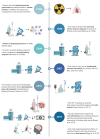Exercise and Childhood Cancer-A Historical Review
- PMID: 35008246
- PMCID: PMC8750946
- DOI: 10.3390/cancers14010082
Exercise and Childhood Cancer-A Historical Review
Abstract
Childhood cancer survivors are at risk of developing important adverse effects, many of which persist for years after the end of treatment. The implementation of interventions aiming at attenuating tumor/treatment-associated adverse effects is therefore a major issue in pediatric oncology, and there is growing evidence that physical exercise could help in this regard. The present review aims to summarize the main milestones achieved in pediatric exercise oncology. For this purpose, we conducted a systematic review of relevant studies written in English in the electronic database PubMed (from inception to 14 August 2021). This review traces the field of pediatric exercise oncology throughout recent history based on three fundamental pillars: (i) exercise during childhood cancer treatment; (ii) exercise during/after hematopoietic stem cell transplantation; and (iii) exercise after childhood cancer treatment. Accumulating evidence--although still preliminary in many cases--supports the safety and potential benefits of regular exercise (with no major contraindications in general) in the childhood cancer continuum, even during the most aggressive phases of treatment. Exercise can indeed represent an effective coadjuvant therapy for attenuating cancer-related adverse effects.
Keywords: exercise is medicine; leukemia; physical activity; solid tumors; stem cell transplantation; survival.
Conflict of interest statement
The authors declare no conflict of interest.
Figures


Similar articles
-
What are the effects of exercise training in childhood cancer survivors? A systematic review.Cancer Metastasis Rev. 2020 Mar;39(1):115-125. doi: 10.1007/s10555-020-09852-3. Cancer Metastasis Rev. 2020. PMID: 31970589
-
Effects of Exercise Interventions on Immune Function in Children and Adolescents With Cancer and HSCT Recipients - A Systematic Review.Front Immunol. 2021 Sep 27;12:746171. doi: 10.3389/fimmu.2021.746171. eCollection 2021. Front Immunol. 2021. PMID: 34646274 Free PMC article.
-
Effects of Combined Interventions of Physical Activity and Diet in Childhood Cancer Survivors: A Systematic Review.Children (Basel). 2024 Jul 13;11(7):853. doi: 10.3390/children11070853. Children (Basel). 2024. PMID: 39062301 Free PMC article. Review.
-
The future of Cochrane Neonatal.Early Hum Dev. 2020 Nov;150:105191. doi: 10.1016/j.earlhumdev.2020.105191. Epub 2020 Sep 12. Early Hum Dev. 2020. PMID: 33036834
-
The effect of weight management interventions that include a diet component on weight-related outcomes in pregnant and postpartum women: a systematic review protocol.JBI Database System Rev Implement Rep. 2015 Jan;13(1):88-98. doi: 10.11124/jbisrir-2015-1812. JBI Database System Rev Implement Rep. 2015. PMID: 26447010
Cited by
-
Safety, Feasibility and Efficacy of Lokomat® and Armeo®Spring Training in Deconditioned Paediatric, Adolescent and Young Adult Cancer Patients.Cancers (Basel). 2023 Feb 16;15(4):1250. doi: 10.3390/cancers15041250. Cancers (Basel). 2023. PMID: 36831593 Free PMC article.
-
Childhood cancer patients' experiences of a structured exercise program. A qualitative study using reflexive thematic analysis.Front Pediatr. 2025 Mar 26;13:1547822. doi: 10.3389/fped.2025.1547822. eCollection 2025. Front Pediatr. 2025. PMID: 40206457 Free PMC article.
-
Is an Exercise Program for Pediatric Cancer Patients in Palliative Care Feasible and Supportive?-A Case Series.Children (Basel). 2023 Feb 7;10(2):318. doi: 10.3390/children10020318. Children (Basel). 2023. PMID: 36832447 Free PMC article.
-
The evolution of nutritional care in children and young people with acute lymphoblastic leukaemia: a narrative review.J Hum Nutr Diet. 2025 Feb;38(1):e13273. doi: 10.1111/jhn.13273. Epub 2024 Jan 7. J Hum Nutr Diet. 2025. PMID: 38185902 Free PMC article. Review.
-
Associations of Physical Activity and Handgrip Strength with Different Domains of Quality of Life in Pediatric Cancer Survivors.Cancers (Basel). 2022 May 23;14(10):2554. doi: 10.3390/cancers14102554. Cancers (Basel). 2022. PMID: 35626159 Free PMC article.

